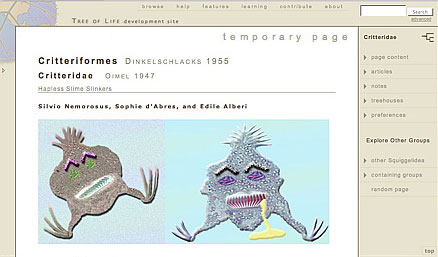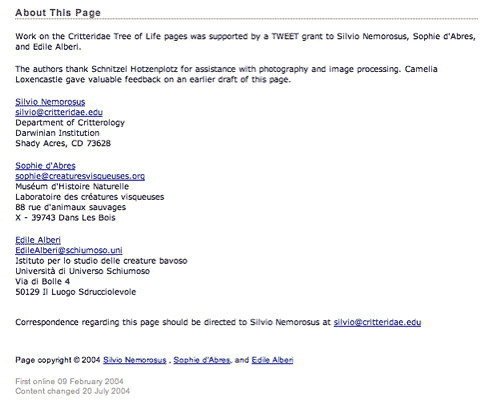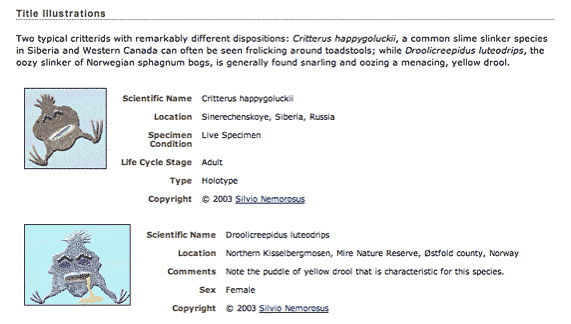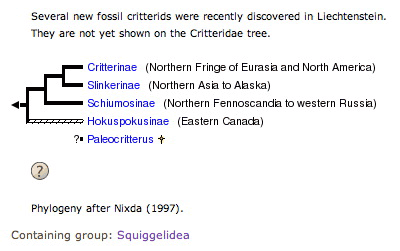Design of Tree of Life Branch Pages
Branch pages are Tree of Life pages about groups of organism that can be divided into subgroups representing distinct genetic lineages. For example, a branch page may be about a group of related species, or it may be about a genus, a family, or a group of related families.
This page gives an outline of our expectations of the content and format of the different sections of a ToL branch page. For more general issues relevant to ToL page design, please also have a look at Tips & Guidelines for ToL Page Authors.
Components of a ToL Branch Page:
- Page Status
- Titles, Subtitles, Supertitles
- Author Credits etc.
- Title Illustrations
- Tree/Taxon List
- Text Sections
- References & Internet Links
- The Right Sidebar
- Example Pages
Page Status
The status of a branch page is indicated in the upper right corner of the white content box. All pages start out as temporary pages, and higher page status levels are assigned by a ToL editor or coordinator after the page has been reviewed. See Status of Tree of Life Pages for information about relevant policies.

Titles, Subtitles, Supertitles
The Group Name you enter in TreeGrow's Tree Window or in the ToL Web Tools Taxon Names form will usually be used as the title of your branch page. The Group Name should be the full name of the entire group. This will usually be the scientific name, but common names can also be used if they are well established and unequivocal. Here are a few guidelines on the use of Group Names:
- Do not use names that refer only to some part of your group (e.g., not "Basal Coleoptera")
- Do not include information on ranks in your group name (e.g., not "Order Coleoptera")
- In the case of subgenera or subspecies, use the full name, not just the name referring to the subtaxon (e.g., Rhyzodiastes (Rhyzostrix) rather than just Rhyzostrix).
- Always use the most specific scientific name available for a group; i. e., in the case of a monotypic genus, use the name of the species, not the name of the genus as the group name.
 You
can use
subtitles and supertitles to accommodatae other taxon names, e.g.,
common names or names of higher taxonomic categories (if multiple
categories
apply to a single node). In addition, you can choose to
display author
data for names. See Taxon Names
for information on
how to enter this information and how to get it to
show up on a
page.
You
can use
subtitles and supertitles to accommodatae other taxon names, e.g.,
common names or names of higher taxonomic categories (if multiple
categories
apply to a single node). In addition, you can choose to
display author
data for names. See Taxon Names
for information on
how to enter this information and how to get it to
show up on a
page.
Author Credits etc.
The names of page authors are printed at the top of the page, and their contact information is printed in the About This Page section near the bottom of the page. The authors' names at the top function as links to the About This Page section. Contributors' addresses, emails, and homepage urls are retrieved from the registration data in the ToL database, so page authors don't have to worry about entering these data once a person has been registered. Acknowledgments of funding agencies or people who helped in the creation of a page are also featured in this section, along with statistics about the page's publication and revision history.

Title Illustrations
Each ToL branch page should contain at least one picture of a representative member or members of the group. Your title illustrations should give the reader a general impression of what the organisms in your group look like. Therefore, they should generally show whole organisms (or substantial portions), not just certain body parts. Good pictures of live specimens are preferred whenever they are available. For some organisms, especially rare or extinct groups, this will not be possible.
You can choose to have a single title picture, or you can display several pictures next to one another. Ideally, if more than one species is pictured, they should span the phylogenetic and structural diversity of the group; for example, the beetle page has four species pictured, one from each of the suborders. If there are several different life forms represented in your group, e.g., trees, shrubs, and forbs, it would be good if your title images could hint at this diversity. It is also good to include well-known members of the clade, or representatives of the most speciose subgroups. It will often be impossible to show all of this, so some compromise needs to be reached.
For general information about finding and processing images for ToL pages, please have a look at Illustrations for Tree of Life Pages.
Moving the cursor over a title image will pop-up a
floating box containing
information about this image (in javascript
enabled browsers only). Also,
title images are linked to the
Title Illustrations section
near the bottom of the page.
In this section thumbnails of the title images
are displayed alongside
image data and/or a custom caption written for
the given title image
array.
Tree/Taxon List
Each branch page features a phylogenetic tree or, if phylogenetic information is not available, a simple list of the taxa contained in a group. For advice on choosing an appropriate scope of taxa to be included in individual ToL pages, refer to the page on Dividing the Tree.

The tree/taxon list is the navigational center of a branch page. The tree diagram contains a link to the page of the containing group (from the root) as well as links to the pages of the groups descending from the current group. Trees and lists can be formatted to indicate special properties of taxa, e. g., extinct, non-monophyletic, uncertain phylogentic placement. Also, authors can add brief descriptions to the taxon names in a tree or list. These descriptions can be used to provide information that may make it easier for non-specialists to recognize or interpret a given group of organisms; e. g.:
- a brief description of the kinds of organisms contained within the
group, e. g.:
- name = Vampyrellids, description = (fungus- and algae-eating protists)
- name = Rana (Pelophylax), description = (A group of water-bound frogs inhabiting Eurasia)
- a list of well-known
subgroups, e. g.:
- name = Basidiomycota, description = (mushrooms, rusts, smuts, etc.)
- name = Therapsida, description = (mammals and their extinct relatives)
For more information on options for manipulating the display of the tree or list, refer to the Tree/Taxon List Formatting page.
Authors can add brief comments immediately above or below the tree or taxon list. Literature sources and features of the tree that are important for navigation should be listed after the tree. For example, on the adephagan beetle page, the text after the tree mentions and provides links to two groups of adephagans that coleopterists might expect to find as terminal taxa in the tree, but which don't appear there.
On each branch or leaf page, the name of the current group's containing group is indicated immediately below the tree or taxon list, and this name constitutes a link to the page of this group.
Trees are built in TreeGrow's Tree Window and links to the containing group and descendent taxa are implemented automatically. Taxon names can be edited in the ToL Web Tools Taxon Names form, and this is also where authors can enter comments to be displayed either above or below the tree.
Text Sections
ToL branch pages feature three standard text sections: Introduction, Characteristics, and Discussion of Phylogenetic Relationships. A complete branch page should feature all three of these sections. Authors can create additional text sections focussing on important aspects of an organism's biology. Text sections can be illustrated with images, but only include images that have a clear relationship to the text. Also, please be sure to add a caption for each image.
Sometimes ToL authors inquire about including text on their ToL pages that has been previously published or that they wish to publish elsewhere in the future. If you consider using such text on your page, make sure to look at the page on copyright issues.
- Introduction
- Characteristics
- Discussion of Phylogenetic Relationships
- Other Topics: Custom Text Sections
Introduction
The Introduction should introduce the members of your group. What kinds of organisms are they, what is unique about them, and in what context might the reader have encountered these organisms before? You might talk about the number of species, geographic distribution, relationship to humans, morphological variation, well-known members of the group, habits of the organisms, habitats, etc.
The Introduction should not include extensive discussions of any particular topic, and it should be kept relatively brief. If you want to include more information about a particular topic, consider placing it in a separate section. Generally, one to four paragraphs are appropriate for most groups of organisms.
Furthermore, this section should be easy to read (target an educated layman). The Tree of Life project is used a lot in middle and high schools, so we want at least a few sections near the top of the page that can be read by non-biologists.
Characteristics
The Characteristics section generally follows immediately after the Introduction. It should talk about the general characteristics of the members of your group. It might describe some of the unique structural or ecological features of the group, perhaps including a small picture or two. A description of prominent synapomorphies of the group would be valuable. The start of the Characteristics section should be easy to read (target an educated layman), but in later paragraphs it can digress into jargony details for the biologist.
The information contained in the Characteristics section should apply to the entire group represented on a page, not just to certain terminal taxa. Detailed information about terminal taxa should be contained on the pages for those taxa, and if a subset of the terminal taxa on a given page have shared characteristics that are worth talking about, you should consider creating a separate ToL page for that group. (Refer to the page on Dividing the Tree for advice on proper criteria for breaking up the tree into individual Tree of Life pages.) The tendency to focus on particular terminal taxa will be especially strong if one of the terminal taxa is much better known than the rest. However, ToL branch pages should be concerned with all the members of a given group, and authors should aspire to balance the information given on each page accordingly. In general, the most that should be said about any particular subgroup is a brief sentence or two (see the beetle page for an example).
There are two reasons for focusing on the entire group rather than a few terminal taxa. First, separating information to the relevant page will reduce redundancy. But more importantly, over-emphasis on certain terminal taxa will obscure the phylogenetic world view presented in the ToL. For example, consider the page for Chordata. The only well-known group within chordates are the vertebrates, and it might seem natural to concentrate on vertebrates on the chordate page. However, this would de-emphasize the unity of the Chordata as a whole and the fascinating connection between such morphologically divergent creatures as sea squirts and birds.
Discussion of Phylogenetic Relationships
The Discussion of Phylogenetic Relationships is a commentary on the tree or taxon list displayed at the top of the page. It should contain a reasonable and fair discussion of alternative hypotheses for the phylogeny of all the subgroups of your group. It should not generally discuss the phylogenetic placement of your entire group; this question is to be addressed on the page of the current group's containing group. If you think it is necessary to add information that is not already available in the Discussion of Phylogenetic Relationships on the containing group's page, you can erect a separate section on the current page called "Relationships of [Your Group] to other [Containing Group]". Of course, this makes sense only if you are not also the author of the containing group's page.
In general, the Discussion of Phylogenetic Relationships should not go into detailed arguments about evidence, but it should concisely summarize the strengths and weaknesses of the various hypotheses. Thus, it should not be simply a list of apomorphies for various nodes; that sort of detail can be presented on a linked accessory page. In your discussion, please mention whether the relationships displayed in the tree were the result of a formal phylogenetic analysis, and make sure to point out those parts of the phylogeny that are more solidly supported than others. You should also explain what kinds of characters (molecular, morphological, skeletal, larval, one or several character systems, etc.) the hypotheses are based on. Summaries of both morphological and any molecular evidence should be provided, and images of alternative phylogenies should be displayed, if possible.
The Discussion of Phylogenetic Relationships should focus on phylogeny, not classification. However, some discussion of past classifications might be necessary, if those classifications were intended to make claims about phylogeny but were not accompanied by an explicit phylogenetic tree. If you wish to discuss the nomenclature and classification of the group, that can be done in a separate custom section.
Other Topics: Custom Text Sections
Branch page authors can erect additional text sections according to the special requirements of their group. Such additional topics may provide information about biogeography, life history, life cycle, fossil specimens, putative characteristics of the ancestor of the group, topics relating the organisms to humans (e.g., medical importance, economic importance), etc. In order to keep branch pages at a manageable size, custom text sections should not be too long, and there should not be too many of them on any given page. Also, branch pages should not take too long to load in a browser, so large illustrations should be avoided. If you would like to provide detailed information (i.e., more than three or four paragraphs) or large media files for any particular topic, or if there are many different topics worth covering for your group, you should consider creating scientific articles or notes for some of your topics.
References & Internet Links
The References section should contain the bibliographic references for your group. These should follow the format used in the journal Systematic Biology. The references should include not only cited papers, but also other general references about the group.
The Information on the Internet section provides links to other internet sites that contain information about your group. We request that you generally list only those links that focus exclusively or extensively on your group; i.e., a site about "Australian Mammals" should be listed on the Mammals page and on the Marsupialia page, but there is no need to repeat this link on the ToL page of every single kangaroo genus. Of course, if the site has a nice page about a certain kangaroo genus, then there can be a deep link directly to this page from the ToL page of that genus. If you come across good web sites that should be featured on ToL pages that you are not in charge of, you can always send us a suggestions to include these links on other people's pages.
Please note that the Information on the Internet section is subject to editorial revisions without notice. We may occasionally check and update the links in this section, and we may also add relevant links that we come across or that are sent to us by other people. If we ever add a link that you would rather not have on your page, please send a request to remove it to
The Right Sidebar
The right sidebar of a ToL branch page contains a table of contents for the current page as well as links to other ToL pages providing information about the current group and related groups. For a detailed explanation of the links contained in the sidebar, refer to Navigating the Tree of Life. All of the links in the sidebar are created automatically based on the relationships between taxa in the ToL database and attachments of objects such as articles, notes and treehouses to nodes in the tree.
Example Pages
Here are some ToL branch pages that new authors can use as models for building their own pages:
- Eukaryotes
- Homobasidiomycetes (Mushroom-Forming Fungi)
- Polemoniaceae (Phlox Family)
- Annelida (Worms)
- Terrestrial Vertebrates
 Go to quick
links
Go to quick search
Go to navigation for this section of the
ToL site
Go to detailed links for the ToL site
Go to quick
links
Go to quick search
Go to navigation for this section of the
ToL site
Go to detailed links for the ToL site